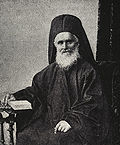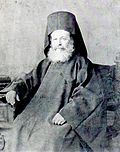Top Qs
Timeline
Chat
Perspective
List of ecumenical patriarchs of Constantinople
From Wikipedia, the free encyclopedia
Remove ads
The following is a chronological list of bishops and ecumenical patriarchs of Constantinople. The historical data on the first 25 bishops is limited with modern scholars debating their authenticity. The Foundation of the See by Andrew the Apostle is met with similar amounts of skepticism with scholars believing it to be a later tradition.[a] The list is mostly based on the compilation made by Demetrius Kiminas,[4] but there is no single "official" numbering of bishops. The official website of the patriarchate has a list of holders but gives them no numeral.[5][b]
This article needs additional citations for verification. (January 2025) |
Remove ads
Bishops of Byzantium (until 330 AD)
- St. Andrew the Apostle (36–38), founder
- St. Stachys (38–54)
- St. Onesimus (54–68)
- Polycarpus I (69–89)
- Plutarch (89–105)
- Sedecion (105–114)
- Diogenes (114–129)
- Eleutherius (129–136)
- Felix (136–141)
- Polycarpus II (141–144)
- Athenodorus (144–148)
- Euzois (148–154)
- Laurence (154–166)
- Alypius (166–169)
- Pertinax (169–187)
- Olympianus (187–198)
- Marcus I (198–211)
- Philadelphus (211–217)
- Cyriacus I (217–230)
- St. Castinus (230–237)
- Eugenius I (237–242)
- Titus (242–272)
- Dometius (272–284)
- Rufinus (284–293)
- Probus (293–306)
- St. Metrophanes (306–314), first bishop mentioned by contemporaneous sources
- St. Alexander (314–330), first bishop of Constantinople
Remove ads
Archbishops/Patriarchs of Constantinople
Summarize
Perspective
The official title of the bishop became "archbishop of Constantinople, New Rome, and ecumenical patriarch" in the 6th century, but scholars often use the terms "archbishop" and "patriarch" for earlier bishops. The First Council of Constantinople (381) concluded that "the bishop of Constantinople, however, shall have the prerogative of honor after the bishop of Rome", while the Council of Chalcedon (451) concluded that "the bishop of New Rome shall enjoy the same privileges as the bishop of Old Rome". Modern scholars use the term "patriarch" after either 381 or 451.[c] The chronology mostly follows Demetrius Kiminas (2009),[4] who mostly uses the dates established by Venance Grumel (1958).[9] See also the lists in the Oxford Dictionary of Byzantium (1991)[10] and the Encyclopedia of the Byzantine Empire (2015).[11]
330–450
450–800
During the 16th session of the Council of Chalcedon (October–November 451), also known as the Fourth Ecumenical Council, a resolution was passed elevating the See of Constantinople to a status equal to Rome in ecclesiastical matters, granting it second place after Rome.[12] The resolution was formally rejected by the Pope Leo I and the Western church; however, it was largely accepted in the East, becoming known as Canon 28. This canon would later become the foundation of the Pentarchy of patriarchates.
800–1060
In 1054, the Eastern Orthodox Church cut ties to the Roman Catholic Church as a result of the Great East–West Schism.

1060–1204
1208–1261 (in Nicaea)
On 12 April 1204, the Fourth Crusade sacked and conquered Constantinople. The Crusaders established their own line of Catholic patriarchs in the city, while the former Orthodox patriarch John X fled in exile to Thrace. John X died in Thrace in the spring of 1206.[14]
After 1204, various Byzantine warlords struggled to establish their legitimacy and sought to reconquer Constantinople. One of the major contenders, Theodore I Laskaris of Nicaea, sought legitimacy through religion. He invited John X to Nicaea, though the deposed patriarch refused the invitation up until his death.[14] After John's death, Laskaris sent letters to Pope Innocent III in hopes of authorizing Orthodox clerics to elect a new Orthodox patriarch and seeking recognition of himself as the supreme head of the Orthodox community, though both requests were ignored by the pope.[15] In 1208, Laskaris nevertheless appointed his own new patriarch, Michael IV of Constantinople, who in turn formally crowned Laskaris as emperor.[16] The status of the "Patriarchs of Constantinople" based in Nicaea remained disputed outside of the Empire of Nicaea until the reconquest of Constantinople in 1261.[17]
Constantinople was captured by the Empire of Nicaea on 25 July 1261. The Emperor and his court arrived to Constantinople the next month. The Latin (Catholic) Patriarchate of Constantinople continued in exile until 1964.
1261–1453
On 29 May 1453 Constantinople fell to the Ottoman Turks, thus marking the end of the Byzantine Empire. The Ecumenical Patriarchate of Constantinople became subject to the Ottoman Empire.
1453–1466
There are different suggestions by scholars for the succession of the Patriarchs from 1462 to 1466, all of whom resigned. The main positions are the following:
|
According to Kiminas (2009):[4]
|
According to Laurent (1968):[18]
|
According to Gemanos of Sardeis (1933–1938):[19]
|
1466–1822
The chronology up to the year 1595 is somewhat disputed by authors.
1822–1923
Greece, which was recognized as an independent country in 1830, adopted the modern Gregorian calendar in 1923, followed by Turkey in 1926. The difference between the Gregorian and Julian calendars is of 12 days, meaning that some sources may give a different date depending on the calendar used (see also Old Style and New Style dates). The list follows the Julian dates used at the time in Greece and the Ottoman Empire.
On 23 July 1833, the Church of Greece declared itself autocephalous. It was followed by the Romanian Orthodox Church in 1864, the Bulgarian Exarchate in 1872, and the Serbian Orthodox Church in 1879, thus reducing the territorial extent of the Ecumenical Patriarchate's jurisdiction.
On 24 July 1923, the Ottoman Empire was dissolved and replaced by the Republic of Turkey.
1923–present
Remove ads
Lengths of tenure
Longest-reigning patriarchs
- Bartholomew (1991–present): 33 years+
- Sergius I (610–638): 28 years, 7 months and 21 days.
- Nicholas III Grammaticus (1084–1111): 26 years and 8 months
- Athenagoras (1948–1972): 23 years, 8 months and 6 days
- Joseph II (1416–1439): 23 years, 1 month and 20 days
- Theophylact Lekapenos (933–956): 23 years and 25 days
- John IX Agapetus (1111–1134): 22 years and 11 months
- Tarasios (784–806): 21 years, 2 months and 24 days
- Saint Jeremias I (2nd term, 1525–1546): 20 years, 3 months and 20 days
- Demetrius (1972–1991): 19 years, 2 months and 16 days
Shortest-reigning patriarchs[k]
- Callinicus III (19–20 November 1726): 1 day
- Neophytus V (20–25 October 1707): 5 days
- Cyril II of Constantinople (4–11 October 1633) and Gabriel II (23–30 April 1657): 7 days
- Cyril III of Constantinople (June 1652): 8 days
- Dositheus of Constantinople (February 1189): 9 days
- Athanasius III Patelarios (2nd term, June 1653): 15 days
- Matthew II (3rd term, January 1603): 17 days
- Matthew II (1st term, February 1596): 20 days
- Cyril Lucaris (1st term, October 1612): 21 days
- Athanasius III (1st term, February–April 1634): 1 month and a few days
Patriarchal names
Summarize
Perspective
The most frequently used patriarchal name is John, with 14 ecumenical patriarchs taking this name. There have also been 74 patriarchal names that have only been used once. The number of all patriarchs to the present is 269.
Remove ads
Notes and references
See also
External links
Wikiwand - on
Seamless Wikipedia browsing. On steroids.
Remove ads









































